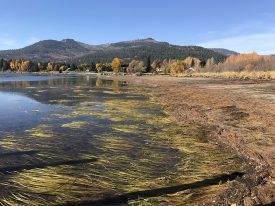from Aquatechnex, Gold Sponsor of 2017 WALPA Conference

This site on the Pend Oreille River in North Idaho was dominated by Eurasian milfoil a decade ago, now rapidly being replaced by flowering rush. The Pend Oreille River flows to the Columbia River, where we are now starting to see problems.
Butomus umbellatus, or flowering rush, is a perennial freshwater plant native to Eurasia and an introduced species in the Northern Tier of the U.S. This invasive aquatic weed has plagued lakes in the Midwest for a number of years. Closer to home, it became established in Flathead Lake, Montana, where by 2011 this weed was infesting over 2,000 acres. Flowering rush can grow as a shoreline emerged plant in shallow water or as a submerged aquatic weed in deeper waters.
Flathead Lake is in the headwaters of the Columbia River Basin. Flowering rush has spread downstream through the Clark Fork River into Lake Pend Oreille, Idaho. Pend Oreille has had extensive problems with Eurasian water milfoil, and the flowering rush moving into that system is rapidly displacing the milfoil. Researchers have documented significant impacts to native fish populations from this invasion of Flathead Lake; it has altered the predator/prey relationship and native fish are being impacted by non-native northern pike that thrive in these rush communities.
Since the Pend Oreille River drains to the Columbia River, the spread continues downstream. There are now patches of this invasive weed appearing below the Grand Coulee Dam, meaning that flowering rush is starting to establish in the riverine environment where our remaining salmonid runs live. This is bound to impact spawning habitat and may also cause increased predation of downstream-migrating juvenile salmonids, which is of special concern since many of these salmonid species are already listed as endangered or threatened.
Aquatechnex has been working with the U.S. Army Corps of Engineers (USACE) Aquatic Plant Control Research Program for the past five years to try and better understand how to control this invasive aquatic weed.
The first work done under this program was treating a 10-acre plot on Lake Pend Oreille with a combination of an herbicide to knock down growth in the water column, and Sonar aquatic herbicide to target the reproductive structures in the lake sediments. This study started in 2013, lasted one year, and resulted in a 72% reduction in frequency occurrence in the treatment plot. Although no sampling was performed in the second year after treatment, aerial photography over this site in 2015 showed the treatment plot essentially clean of vegetation. So this approach seems to have promise where conditions allow.
The USACE, Bonner County Weed Control and our Aquatechnex group also looked at drawdown applications from 2015 through summer 2017. Lake Pend Oreille is subject to a 10-foot drawdown most years to help mitigate the impact of invasive lake trout on Kokanee salmon populations in the lake. This exposes the lakebed, where flowering rush is well established in many areas. In 2015, a number of herbicide combinations were applied to the exposed lake bottom just before spring stabilization of the lake level. Corps personnel collected core samples from the lake sediments in both replicated treatment plots and from reference plots before the treatments in 2015 and in the spring of 2016 and 2017. Two aquatic herbicides — imazapyr and imazamox — provided good control in year one and brought significant reductions in root and shoot biomass. The study suggests that while one year of treatment provides control for that year, treating the areas two years in a row provides longer term control. This approach is also much more cost effective than conventional “through the water column” treatments as application rates are in the quart per acre range vs. gallons per acre.
Lastly, we have done two years of work with Diquat herbicide on 10- and 14-acre treatment plots at various locations on Lake Pend Oreille. In these trials, Diquat provided excellent year of treatment control of flowering rush. The 2016 treatment plot saw 87% control based on point intercept data five weeks post-treatment. In the summer of 2017, regrowth had occurred and control, based on point intercept data, dropped to about 30% one year post-treatment. This plot was treated a second time with 100% control achieved six weeks post-treatment and will be evaluated again this coming summer. Researchers in Minnesota have found that they can get good long-term control after two years with two applications per growing season.
While we need to keep learning about how to control this extremely invasive aquatic weed, we have found a couple of ways to start the fight. It is likely that the Columbia River will be severely impacted by this invasive aquatic weed in the coming years. Lake managers need to get this weed on their radar and keep an eye out for it.
Aquatechnex biologists presented this work at the Flowering Rush Summit in Spokane at the end of February. That presentation is available to interested parties from tmcnabb@aquatechnex.com.









